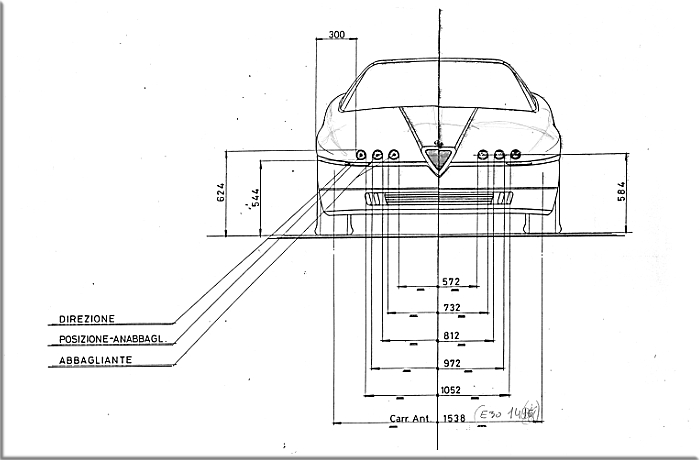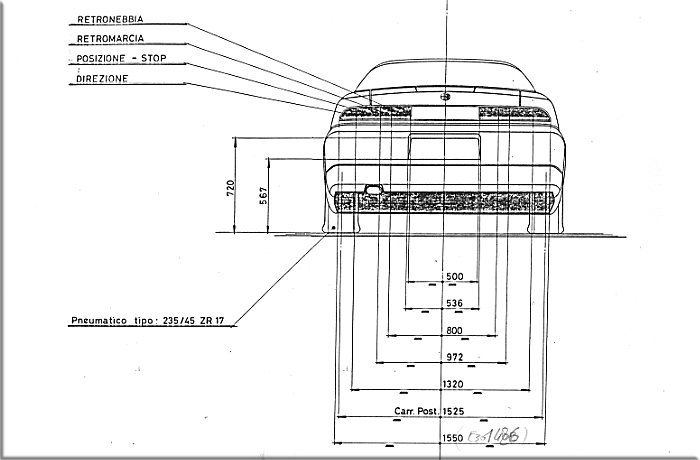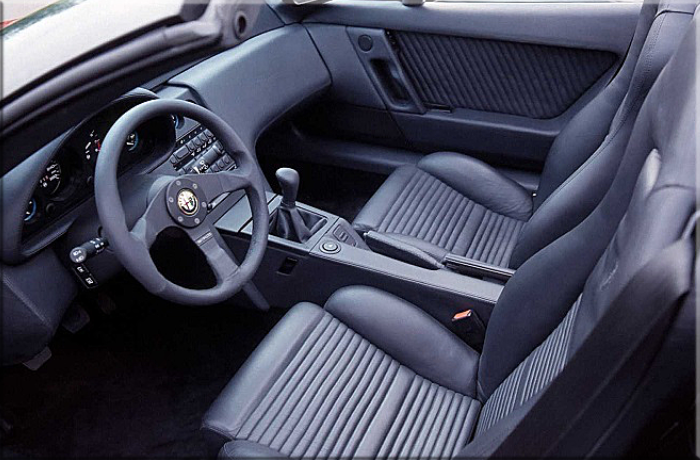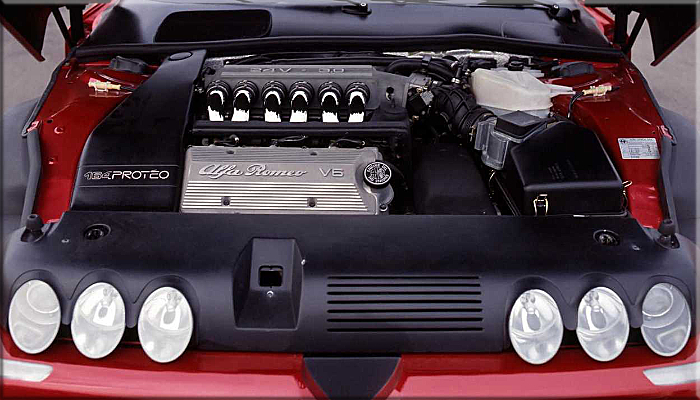FEBRUARY 1990
 1989 December Milan Portello. The first sketch of the Alfa Romeo Proteo by Alberto Bertelli.
1989 December Milan Portello. The first sketch of the Alfa Romeo Proteo by Alberto Bertelli.
For many years the Fiat Group has not created concept cars for motor shows, and in the first days of February 1990 Alfa Romeo decided to present an innovative, fully functional prototype with very high technological content for the future 1991 Geneva Motor Show. Alberto BertelliGiven the experience gained in the style modeling sector, and the growth of the design office, despite not having specific experience in the concept sector, Fiat's top management decided to entrust STOLA s.p.a. this work.
Alberto BertelliGiven the experience gained in the style modeling sector, and the growth of the design office, despite not having specific experience in the concept sector, Fiat's top management decided to entrust STOLA s.p.a. this work.
The first meeting will take place in Milan in the historic Alfa Romeo Style Center in Portello, now almost disused due to the imminent transfer to Arese which will take place two weeks later.
Present at the meeting were Alfa Romeo Walter De Silva Director of Design, Alberto Bertelli the designer and Benedetto Carmelo of Design, and Stola S.p.A. Gottardo Bustreo, Director of Design, is present, together with Roberto and Alfredo Stola.
At this meeting Bustreo will present the preliminary general feasibility studies on immense rolls of drawing paper and in particular the rough idea of the innovative rigid top broken down into two parts which can be completely disappeared through a carbon cover, an aesthetically integral part of the bodywork. .
Obviously the movement will have to be automated and what's more the two parts of the hood will be made of glass.
The desire of the Alfa Romeo Style Center, at that time still for a short time located at Portello, (it will then be moved to Arese in a brand new building) is to amaze by showing the world two versions in a single car, a spider and a coupe without taking away space for luggage in the rear trunk and above all without any compromise on beauty in the two totally distinct configurations.
Over time, the working meetings between the Alfa Romeo men of the Style and Design Center with Gottardo Bustreo and his assistants became almost daily between the respective offices in Arese and Turin / Grugliasco.




 March 1990, start of the milling of the Alfa Romeo Proteo style / Master model.
March 1990, start of the milling of the Alfa Romeo Proteo style / Master model.
The milling machine is a Jobs Jomac 35, the operator is Luigi Sartin.
 March 1990 start of the milling of the Alfa Romeo Proteo style / Master model.
March 1990 start of the milling of the Alfa Romeo Proteo style / Master model.
The milling machine is a Jobs Jomac 35, the operator is Luigi Sartin.


 April 1990 the Alfa Romeo Proteo in the Fiat research center wind tunnel, in Orbassano for the latest aerodynamic refinements to reach the optimal CX.
April 1990 the Alfa Romeo Proteo in the Fiat research center wind tunnel, in Orbassano for the latest aerodynamic refinements to reach the optimal CX.
 April 1990 The almost finished Alfa Romeo Proteo chassis.
April 1990 The almost finished Alfa Romeo Proteo chassis.
It is a slightly shortened and reinforced 164 type.
 April 1990 The Alfa Romeo Proteo chassis almost finished.
April 1990 The Alfa Romeo Proteo chassis almost finished.
It is of the type 164 extension, which is slightly shortened and reinforced.
Over time, the business meetings between the Alfa Romeo’s Centro Stile and Gottardo Bustreo and his assistants became almost daily at their the respective offices in Arese and Grugliasco.
It was a difficult challenge, the bodywork would have to be made entirely of aeronautical carbon, there was a fully retractable folding glass top, 6-cylinder engine and both four-wheel drive and steering.
The top was as extraordinary electrochromic glass object, hydraulically operated and totally retractable.
By pressing a convenient switch positioned inside the passenger compartment the architecture could be transformed in 45 seconds from coupe to spider and vice versa, without having the impression that one may become the other.
 October 1990 from left Alfredo, Bustreo, Ardagna and Robaldo
October 1990 from left Alfredo, Bustreo, Ardagna and Robaldo October 1990 Ardagna, Robaldo, Bertelli and Marco Goffi..
October 1990 Ardagna, Robaldo, Bertelli and Marco Goffi..
 October 1990 Ardagna, Bustreo and Alfredo
October 1990 Ardagna, Bustreo and Alfredo October 1990 The Stola Team and the CP Team at work.
October 1990 The Stola Team and the CP Team at work.
 November 1990 The Teams at work.
November 1990 The Teams at work.
Designer Alberto Bertelli at the wheel,the Cav Giuseppe Civardi (with his hand on the front upright) from the Fiat style center overseeing the work, behind him Mr. Boggio of the CP. Marco Goffi can be seen bottom left.
 November 1990, bottom left Roberto Stola and Cav. Civardi overseeing the Stola and CP Teams.
November 1990, bottom left Roberto Stola and Cav. Civardi overseeing the Stola and CP Teams.
 November 1990 Alfredo Stola with Walter de Silva, Alberto Bertelli and Cav. Civardi.
November 1990 Alfredo Stola with Walter de Silva, Alberto Bertelli and Cav. Civardi.
On the right in the foreground, Stefano Ardagna.
 1990 December Alfredo Stola and Cav. Civardi.
1990 December Alfredo Stola and Cav. Civardi. 1990 December, bottom, Walter de Silva
1990 December, bottom, Walter de Silva
and Maria Paola Stola.
 December 1990 The complete team, at the back, Alfredo Stola, Walter de Silva, Bertelli Tree, Cav. Giuseppe Civardi and Giampiero Boggio. On the right with the white coat, Pautasso a very good panel beater.
December 1990 The complete team, at the back, Alfredo Stola, Walter de Silva, Bertelli Tree, Cav. Giuseppe Civardi and Giampiero Boggio. On the right with the white coat, Pautasso a very good panel beater.
 Here are the finished interiors of the Proteo
Here are the finished interiors of the Proteo
 The Centro Stile Alfa Romeo wanted to surround the mythical 6-cylinder Busso
The Centro Stile Alfa Romeo wanted to surround the mythical 6-cylinder Busso
engine with a refined functional design cover.
Precisely for this characteristic, the name of this car is "Proteo", from the shape changing Greek God- Proteus .
It was a prototype "Spider-Coupé" laboratory, a forerunner of the future Mercedes SLK, SL and BMW Z 4, whose hoods were formed in sheet metal, foldable and totally hidden when open.
Alfa Romeo had a really good idea, the Stola technicians succeeded at engineering and building it; the regret was not having patented it in March 1991.
 The complicated retractable roof of the Proteo imagined by Alfa Romeo and engineered and built by Stola s.p.a
The complicated retractable roof of the Proteo imagined by Alfa Romeo and engineered and built by Stola s.p.a

From the beginning the goal was to build a first salon prototype and to follow that up with two more for technical checks and preliminary feasibility as Fiat Auto’s intention was to put this sports car into production as soon as possible.
For the record, shortly afterwards the project was stopped, of the two technical prototypes only the platforms were built and nothing more.
For Stola that was their first salon prototype, and it brought a lot of luck to the modeling shop because in the following thirteen years, through to the end of July 2004, another fifty-six were made for the most prestigious car manufacturers in the world.
 February 1991 Balocco test track. Mauro Palman
February 1991 Balocco test track. Mauro Palman
and Marco Goffi carry out the prototype
unloading operations. February 1991 Walter de Silva and Madam with the tester Moroni. In the center we can see Siro Palestra
February 1991 Walter de Silva and Madam with the tester Moroni. In the center we can see Siro Palestra
and Gianpiero Boggio.
 February 1991 Mauro Palman and Marco Goffi make sure everything is perfect before the track test.
February 1991 Mauro Palman and Marco Goffi make sure everything is perfect before the track test. February 1991 finally the Proteo is driven by Moroni making its first lap of the track.
February 1991 finally the Proteo is driven by Moroni making its first lap of the track.
 February 1991 at the Balocco track the official photo before the tests.
February 1991 at the Balocco track the official photo before the tests.
 February 1991 Balocco test track. The test driver Moroni performs one hour of testing.
February 1991 Balocco test track. The test driver Moroni performs one hour of testing. February 1991 Balocco test track. The test driver Moroni performs one hour of testing.
February 1991 Balocco test track. The test driver Moroni performs one hour of testing.
 February 1991 Balocco test track. Walter de Silva and Alfredo Stola at the first test of the Alfa Romeo Proteo.
February 1991 Balocco test track. Walter de Silva and Alfredo Stola at the first test of the Alfa Romeo Proteo.
The Alfa Romeo Proteo was presented to the world press on the morning of March 5, 1991 in Geneva on the occasion of the 61st International Motor Show.
In the presence of hundreds of journalists and professionals, the hearts of Roberto and Alfredo Stola, Bustreo, Sasso and Goffi were put to the test during the opening of the convertible top in the presence of the Fiat leaders represented by the 'Agnelli, the lawyer Cesare Romiti and the engineer Paolo Cantarella accompanied by the technical director the engineer Stefano Iacoponi and the director of the Style Center, Walter Da Silva.
Ten minutes earlier, in a final pre-show test of the opening and closing top, it had jammed ...
 March 1991 Geneva Motor Show Marco Goffi
March 1991 Geneva Motor Show Marco Goffi
and Gottardo Bustreo. March 1991 Geneva Motor Show, Alfredo Stola.
March 1991 Geneva Motor Show, Alfredo Stola.
 March 1991 Geneva Motor Show Finally the Proteo on the Stand.
March 1991 Geneva Motor Show Finally the Proteo on the Stand.
 March 1991 Geneva Motor Show . The engineer Paolo Cantarella describes to lawyer Gianni Agnelli and Dr. Cesare Romiti, the complex function of the disappearing glass roof. A few moments later they demonstrate the opening and closing to Marco Goffi for the first time. These were the longest sixty second of the lives of those responsible.
March 1991 Geneva Motor Show . The engineer Paolo Cantarella describes to lawyer Gianni Agnelli and Dr. Cesare Romiti, the complex function of the disappearing glass roof. A few moments later they demonstrate the opening and closing to Marco Goffi for the first time. These were the longest sixty second of the lives of those responsible.
 March 1991 Geneva Motor Show Stefano Iacopone, technical director of Alfa Romeo, Roberto Stola and engineer Alberto Sasso relaxed and smiling after the successful opening and closing of the roof in front of journalists and above all the board of the Fiat group.
March 1991 Geneva Motor Show Stefano Iacopone, technical director of Alfa Romeo, Roberto Stola and engineer Alberto Sasso relaxed and smiling after the successful opening and closing of the roof in front of journalists and above all the board of the Fiat group.


















































